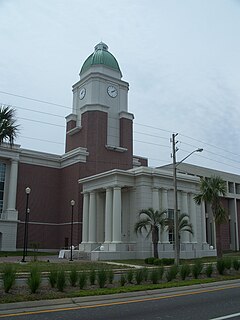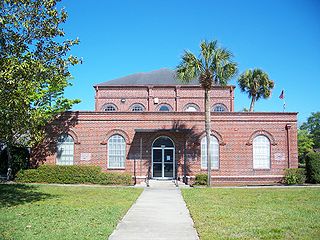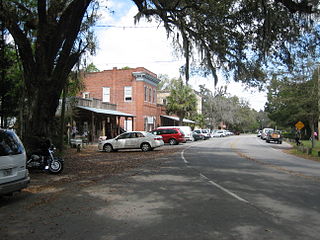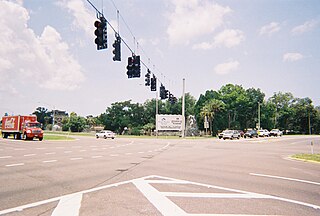
Clay County is a county located in the northeastern part of the U.S. state of Florida. As of 2019, the population was 219,252. Its county seat is Green Cove Springs. It is included in the Jacksonville, FL Metropolitan Statistical Area.

Marion County is a county located in the north central portion of the U.S. state of Florida. As of the 2010 census, the population was 331,298. Its county seat is Ocala.

Alachua County is a county located in the north central portion of the U.S. state of Florida. As of the 2010 census, the population was 247,336. The county seat is Gainesville, the home of the University of Florida since 1906, when the campus opened with 106 students.

Gilchrist County is a county located in the north central part of the U.S. state of Florida. Organized in 1925 from the western part of Alachua, it is the last county to be formed in the state. As of the 2010 census, the population was 16,939. The county seat is Trenton.

Alachua is a city in Alachua County, Florida, United States. According to the 2010 U.S. Census, the city's population was 9,059. The city is part of the Gainesville, Florida Metropolitan Statistical Area, which was home to 264,275 people at the 2010 census.

Archer is a city in Alachua County, Florida, United States. As of the 2010 census, the city had a population of 1,118.

Gainesville is the county seat of, and the largest city in, Alachua County, Florida, and is both the principal city of the Gainesville, Florida, metropolitan statistical area and the largest city in North Central Florida. In 2018 the US Census Bureau estimated Gainesville's population at 133,997, a 7.6% increase from 2010, and the metropolitan statistical area's population at 288,212.

Hawthorne is a city in Alachua County, Florida, United States, incorporated in 1881. Indigenous peoples of the Americas had been living in the area since around 100 CE; Hawthorne grew around their trading trails. Throughout its history, Hawthorne has been known for its agriculture, railroad, and rural lifestyle. Hawthorne's population was 1,417 at the 2010 census, with an area of 7.06 sq mi (18.3 km2).

High Springs is a city in Alachua County, Florida, United States. The population was 5,350 at the 2010 census.

Micanopy is a town in Alachua County, Florida, United States, located south of Gainesville. The population as of the 2010 census was 600. The oldest community in the interior of Florida that has been continually inhabited, it has a downtown that is designated as a historic district, listed on the National Register of Historic Places. It contains a number of antique stores, as well as several restaurants. It is also known for being the filming location of the 1991 romantic comedy, Doc Hollywood.

Newberry is a city located in the southwest corner of Alachua County, Florida, United States. The population was 4,950 at the 2010 census and its population has grown since 1990. The University of Florida estimates the city's population at 6,115 as of 2018. Much of the city borders neighboring Gilchrist County, to the west. The current Mayor is Jordan Marlowe.

Waldo is a city in Alachua County, Florida, United States. According to the 2010 census the population was 1,015, up from 821 in 2000.

Weeki Wachee was a city located in Hernando County, Florida, United States. As of the 2010 census, the former city had a total population of 12. The 12,000-acre (49 km2) Weeki Wachee Preserve and the Weeki Wachee Springs park are located in the area. The park includes water rides, animal shows, mermaid costume shows, and manatee watching. The communities of Weeki Wachee Gardens and Spring Hill are nearby.

Gainesville-Hawthorne State Trail is a rail trail in Florida.

The Alafia River is 25 miles (40 km) long, with a watershed of 335 square miles (870 km2) in Hillsborough County, Florida, United States, flowing into Tampa Bay. The watershed contains ten named lakes and ponds, and 29 named rivers, streams and canals. During the rainy season, excess water is pumped to the new C.W. Bill Young Regional Reservoir, which opened in 2005.

Rochelle is an unincorporated community in Alachua County, Florida, United States. It was found in the 1830s on a former native settlement and mission site. Rochelle was at a junction on the Florida Southern Railway, with lines running to Gainesville, Ocala and Palatka. Citrus growing became important in the area, and in 1885 the town had two sawmills, two churches, two schools, and a couple dozen houses. The Great Freeze of 1894–1895 destroyed the citrus industry in the area, and the town declined afterwards. The Rochelle School closed in 1935.

The Santa Fe River is a 75-mile (121 km) river in northern Florida. The watershed of the river is approximately 1,380 square miles (3,574 km2) and spreads across southern Columbia, southern Suwannee, western Bradford, far southern Baker, Union, northern and eastern Gilchrist, and northern Alachua counties. The headwaters of the river are Lake Santa Fe, near Keystone Heights. The Santa Fe River is usually a slow-flowing river. This slow speed, combined with the abundant leaf-drop from nearby trees, especially Bald Cypress, leads to a very dark-brown river due to dissolved tannins.

Alachua County, Florida is home to six state parks. Two of them are also National Natural Landmarks, one is a historic district, one is a National Historic Landmark, and one is a rail trail. Unless otherwise noted, all of the parks adhere to the Florida State Parks schedule; Florida state parks are open between 8 a.m. and sundown every day of the year.

The Islas del Rosario, also referred to as Corales Islas del Rosario, is an archipelago located off the coast of Colombia, approximately 100 kilometres from Cartagena. It is one of the 46 Natural National Parks of Colombia. The national park was founded in 1988, to protect one of the most important coral reefs of the Colombian Caribbean coast. People can visit the national park area of the islands, and tours are available. Isla Rosario has an aquarium and open-sea oceanarium (oceanario) that people can visit. Activities include swimming, snorkeling and fishing, among others.

Hogtown was a 19th-century settlement in and around what is now Westside Park in Gainesville, Florida, United States where a historical marker notes Hogtown's location at that site and is the eponymous outpost of the adjacent Hogtown Creek. Originally a village of Seminoles who raised hogs, the habitation was dubbed "Hogtown" by nearby white people who traded with the Seminoles. Indian artifacts were found at Glen Springs, which empties into Hogtown Creek. In 1824, Hogtown's population was 14. After the acquisition of Florida by the United States, white settlers began moving into the area. The 1823 Treaty of Moultrie Creek obliged the Seminoles to move to a reservation in central Florida. Under the terms of the treaty, Chief John Mico received $20 as compensation for the "improvements" the Seminoles had made in Hogtown.





















